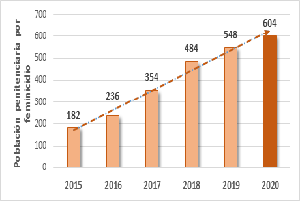The rehabilitation of the convicted for the crime of femicide in a peruvian penitentiary establishment
DOI:
https://doi.org/10.51252/rcri.v2i2.364Keywords:
sentence, femicide, misogynist, physical violenceAbstract
In the last decade, the crime of femicide has reached alarming proportions in society, constituting a serious crisis of insecurity for the life, health and psychological well-being of women; on the other hand, the rehabilitation of the person deprived of their liberty is of the utmost importance for society; Therefore, the main objective of the investigation was to identify the reasons why the Peruvian State should be concerned with the rehabilitation of the convicted femicide interned in the Miguel Castro Castro prison, Lima - Peru. The type of research was basic, descriptive, explanatory and correlational, with a non-experimental design and mixed approach; The survey was used as a technique and a questionnaire containing twenty items with codification of dichotomous responses was used as an instrument for a sample of 130 professionals (units); Likewise, the degree of correlation or association of the research variables was determined by Pearson's Chi-Square test (non-parametric measure), obtaining a result of 45.036a; and, with a level of significance of 0.05, which means that the variables have a medium positive correlation.
Downloads
References
Albarran, J. (2015). Referentes conceptuales sobre femicidio / feminicidio: Su incorporación en la normativa jurídica Venezolana. Comunidad y Salud, 13(2). http://ve.scielo.org/scielo.php?script=sci_arttext&pid=S1690-32932015000200010
Brito Rodríguez, S., Basualto Porra, L., & Posada Lecompte, M. (2021). Femicidio y violencia de género. Percepciones de mujeres chilenas estudiantes de educación superior. Rumbos TS, 16(25), 41–77. https://doi.org/10.51188/RRTS.NUM25.484
Chambergo-Chanamé, C. (2022). Vulneración de la dignidad de la persona humana en centros penitenciarios: una actual realidad alarmante. Revista Científica Ratio Iure, 2(1), e282. https://doi.org/10.51252/RCRI.V2I1.282
INEI. (2021). Perú: Feminicidio y Violencia contra la Mujer 2015-2020. https://observatorioviolencia.pe/wp-content/uploads/2022/03/Peru-Feminicidio-y-Violencia-contra-la-Mujer-2015-2020.pdf
INPE. (2022). Tablero - Establecimientos Penitenciarios. https://inpe.maps.arcgis.com/apps/dashboards/9bfb61bd506f4162b97e3c2fefb53ee2
Lagarde y de los Ríos, M. (2008). Antropología, feminismo y política: violencia feminicida y derechos humanos de las mujeres. In Retos teóricos y nuevas prácticas (Vol. 1, Issue feminicidio, pp. 209–239). http://www.ankulegi.org/wp-content/uploads/2012/03/0008Lagarde.pdf
Lopera Medina, M. M., & Hernández Pacheco, J. (2020). Situación de salud de la población privada de la libertad en Colombia. Una revisión sistemática de la literatura. Gerencia y Políticas de Salud, 19, 1–26. https://doi.org/10.11144/JAVERIANA.RGPS19.SSPP
López Sinisterra, O. (2021). Reincidencia y programas de resocialización en los centros penitenciarios de La Joya y La Joyita. LEX - Revista de La Facultad de Derecho y Ciencias Políticas, 18(26), 441–454. https://doi.org/10.21503/LEX.V18I26.2196
Mendieta Pineda, L. M., Molina Carrión, B. M., & Huertas Díaz, O. (2020). Sistema progresivo penitenciario en Colombia: tratamiento y resocialización. IUSTA, 53, 15–44. https://doi.org/10.15332/25005286.6270
Montero Pérez de Tudela, E. (2018). La reeducación y la reinserción social en prisión: El tratamiento en el medio penitenciario español . Revista de Estudios Socioeducativos. ReSed, 7, 227–249. https://revistas.uca.es/index.php/ReSed/article/view/4421
Russell, D. E., & Harmes, R. A. (2006). Feminicidio: una perspectiva global (UNAM).

Published
How to Cite
Issue
Section
License
Copyright (c) 2022 José Wilmer Fuentes-Ruiz

This work is licensed under a Creative Commons Attribution 4.0 International License.
The authors retain their rights:
a. The authors retain their trademark and patent rights, as well as any process or procedure described in the article.
b. The authors retain the right to share, copy, distribute, execute and publicly communicate the article published in the Ratio Iure Scientific Journal (RCRI) (for example, place it in an institutional repository or publish it in a book), with an acknowledgment of its initial publication in the RCRI.
c. Authors retain the right to make a subsequent publication of their work, to use the article or any part of it (for example: a compilation of their works, notes for conferences, thesis, or for a book), provided that they indicate the source of publication (authors of the work, journal, volume, number and date).






